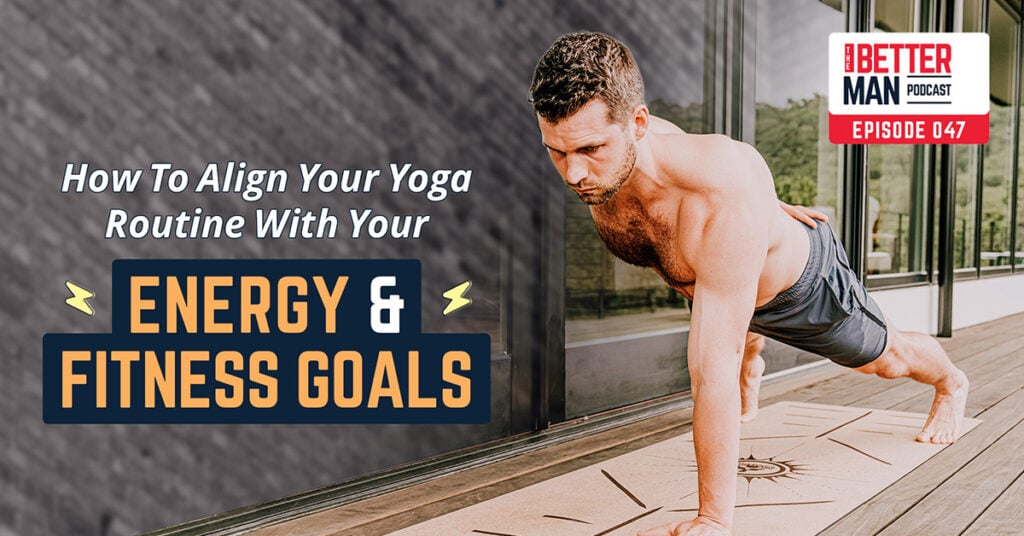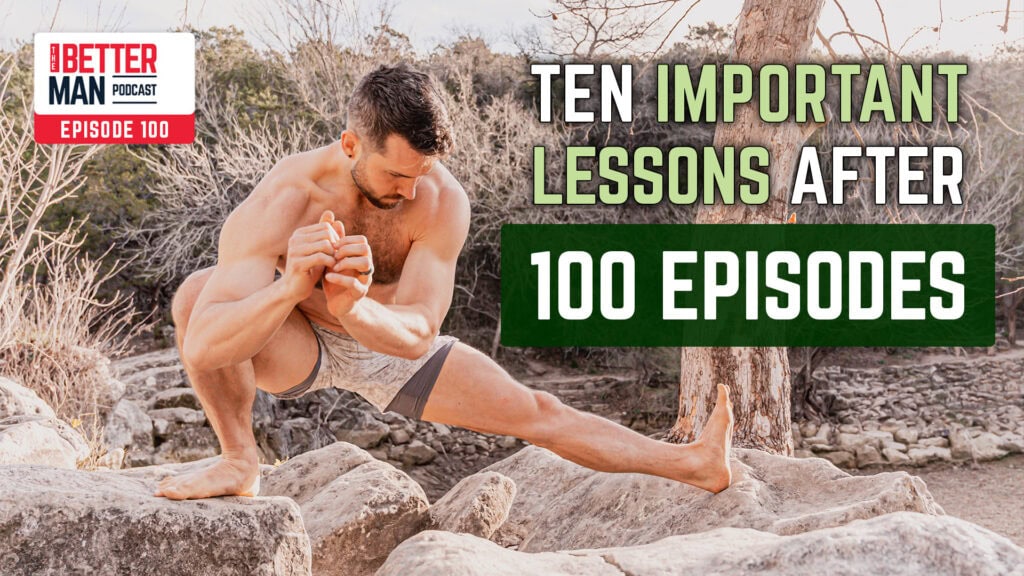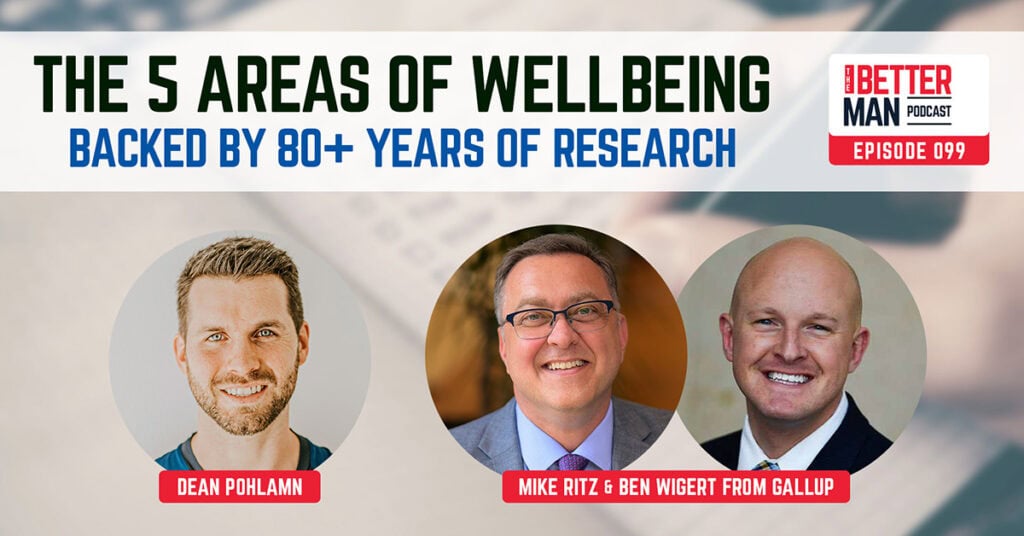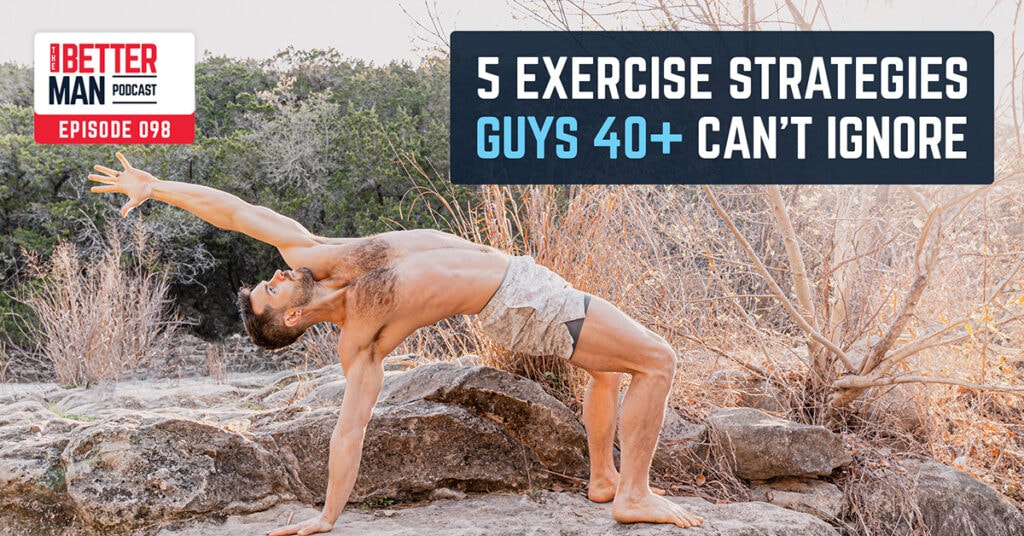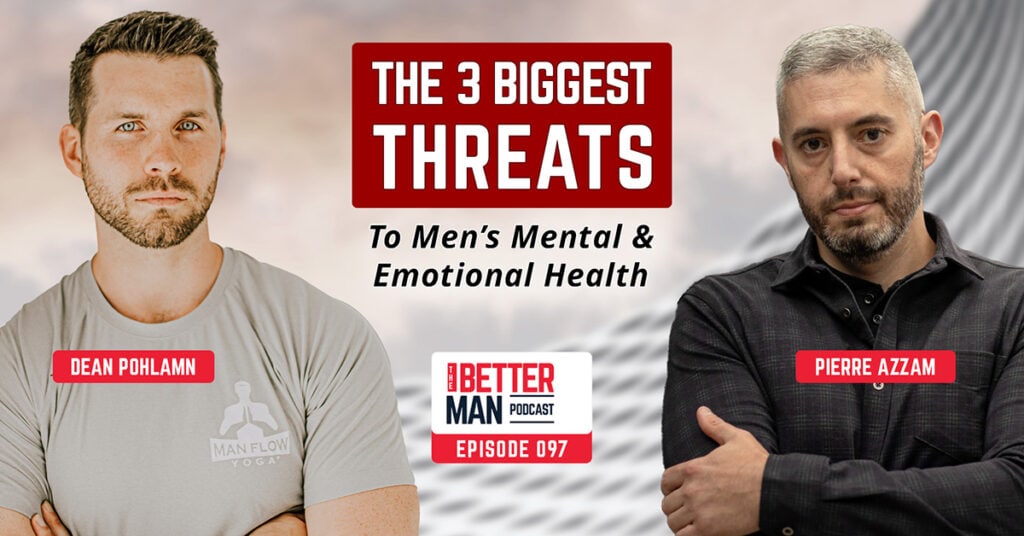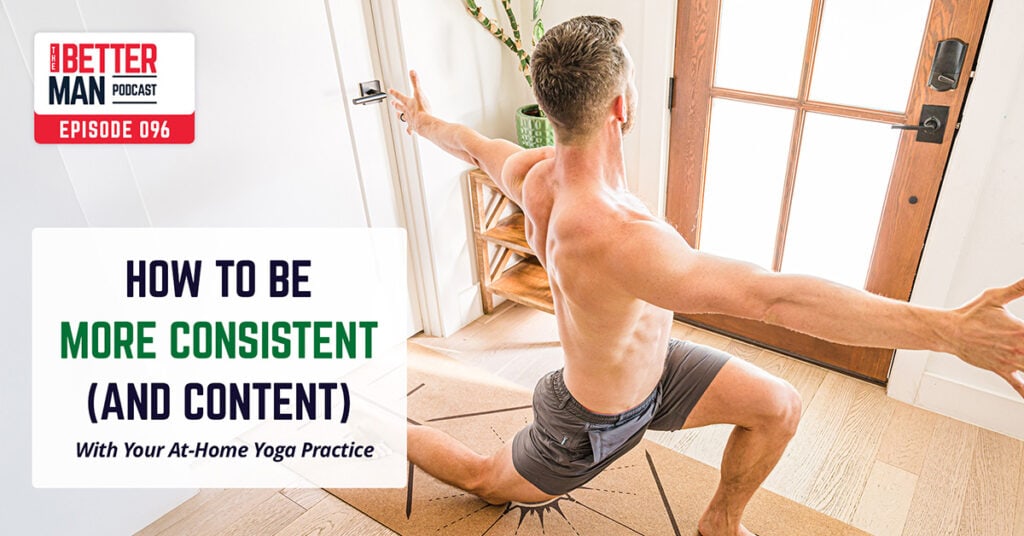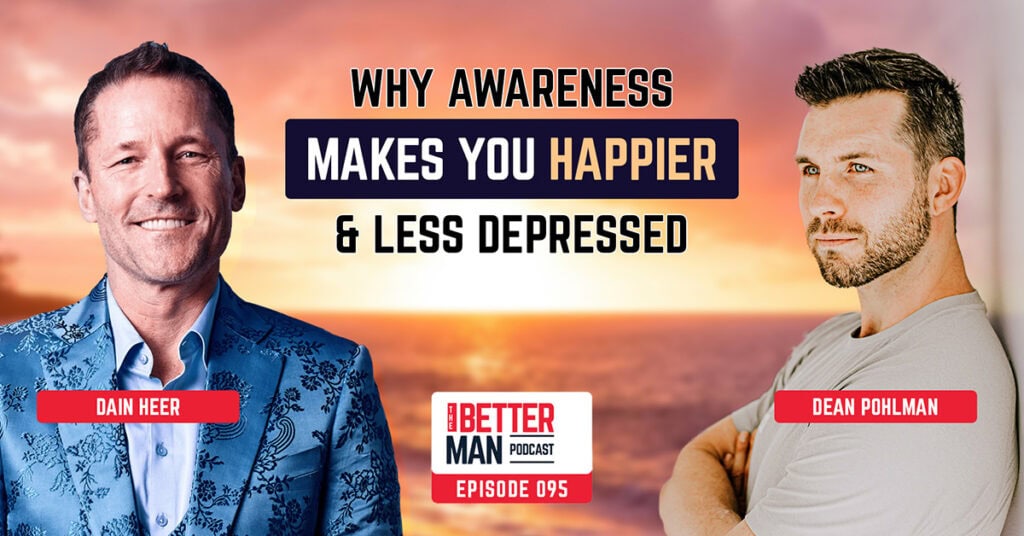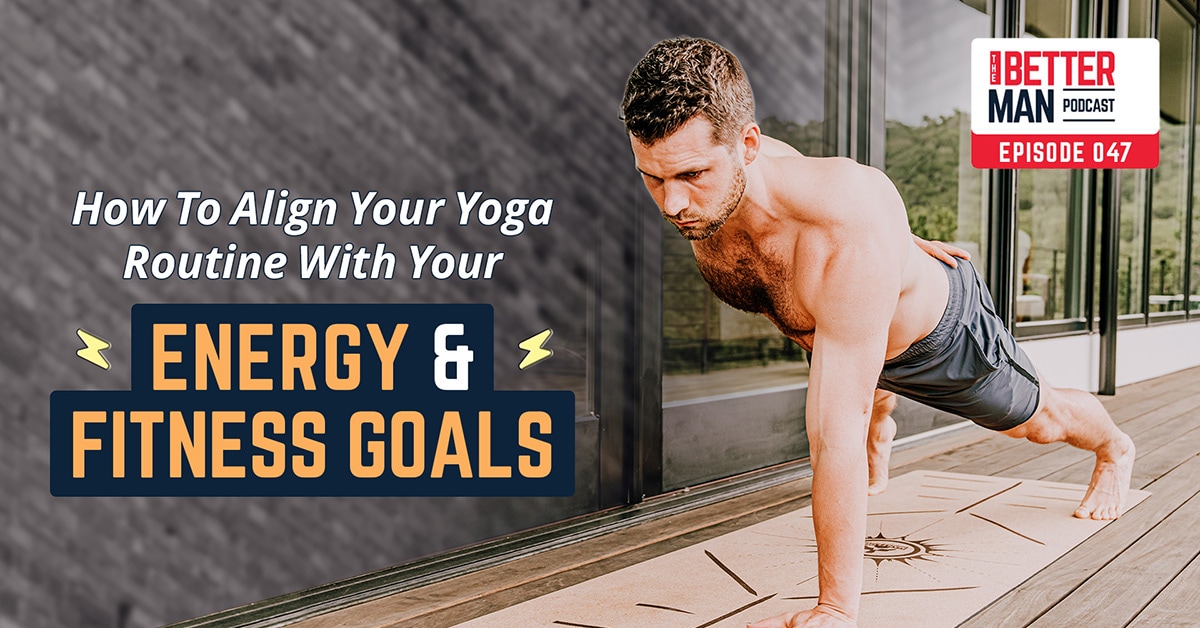Hey guys, it’s Dean. Welcome to the Better Man podcast. This is a solo episode, and in it I’m going to talk about all the different types of ways that you can do yoga. So I’m not going to be talking about different schools of yoga. I’m not going to be differentiating between Hatha, Bikram or yin specifically. I’m going to be talking about how you can do yoga for your fitness, how you can do it for your mental well-being in different ways that you can do the workouts for different goals because there are so many different ways to do yoga.
If you ask somebody, you know what type of yoga do you do? Or they tell you, I do yoga, you’re your question. Then immediately as well, what kind of yoga do you do? There’s so many different ways to do it and I find many different ways of doing yoga beneficial for my own life. So I think that it could be also helpful to you.
We also tend to categorize our workouts a few different ways and Man Flow Yoga, and this makes it so that you know how to use those workouts accordingly. Certain types of yoga are not appropriate for some situations. For example, you don’t want to do a stretching routine before an intense workout. You also don’t want to do an intense yoga workout right after you’ve done another intense workout.
So there are ways that you can do yoga as a standalone workout in ways that you can stack it with other workouts. And it’s good to understand the different ways that you can do it. So that’s what we’re going to get into in this quick but informative solo episode.
So first off, I’m going to talk about kind of the different ways that you can do yoga. So we can do yoga with a higher intensity focus where we where we’re really focusing on building strength, we’re building endurance, we’re working on on balance, we’re working on increasing active range of motion. And this is where you could even integrate some bodyweight exercises into this. And this is where you’re going to have kind of the highest intensity level of yoga, where it’s something that’s similar in intensity to a resistance training workout or a boot camp workout or something that’s really intense like that. And this is this is effective.
This type of workout is effective for building muscle. It’s effective for helping you increase active range of motion. So functional mobility that translates into your other workouts. But it’s not something that’s going to be really helpful for letting you wind down and relax or really tap into the stress relief benefits. So this is one type.
You can also go a little bit lower down in the intensity. We can go to a more medium intensity workout where we’re combining flexibility with strength, with balance, but we’re also doing a fair amount of restorative work where we’re doing more gentle stretches, where we’re not focusing on holding the poses for as long as we possibly can, where we’re getting to the point where we’re really huffing and puffing to be able to maintain. And this is a more overall focus where we start low intensity, we go up to medium intensity, and then we kind of finish with a lower intensity.
You can also do it with a lower intensity that’s mainly focused on flexibility. So this is where we’re really going to focus on using our breath to work deeper into postures. There’s a little bit of strength component here because this is where we do want to be able to increase flexibility, which does require a certain level of muscle activation and strength. But if we were looking at this from an intensity scale of 1 to 5, this wouldn’t be anything above a two or three out of five. And this is this type of workout is really helpful for the day after another workout. This is helpful for if you wait if you don’t get enough sleep the night before and you need something to do instead of your normal workout.
So there’s this is a lower intensity workout and then there’s an even lower intensity workout that I would consider a one out of five intensity where the emphasis is just on getting a nice stretch, where the emphasis is on feeling the stretch in the right areas, breathing really slowing down the breathing, but then holding that pose for holding that stretch for a long time.
The goal here isn’t to increase flexibility at all. It’s to create immediate improvement in the moment so that you feel better at the end compared to when you started. And it’s also more of a mental component; drilling, really, really getting you to focus on the on and on staying in that calm, meditative state of stretching, of breath focus instead of, you know, it really intense workout where it’s easier to stay focused because the intensity is high. When you’re doing something that’s really easy, that’s really low in intensity, that does challenge you. That does challenge you to to have to to focus more.
So in terms of, you know, the times of your workout, I think that any time I spent doing yoga or spent doing yoga postures is is time well spent. You don’t have to, you know, do 60 minutes ever in order to get all the benefits of yoga. I do find, you know, you can just do 2 minutes here and there. I do find that 20 minutes is a really good amount of time that allows you to have enough time to really work on the different aspects of fitness that would go into an effective, you know, fitness focused yoga workout. So like strength, flexibility, balance, while also tapping into some of the mental benefits like that, that focus, the breathing.
So 20 minutes is a really good time for that. 30 minutes is really good. And I find that at 30 minutes, people tend to lose focus. So most people just don’t have kind of the mental discipline to be able to keep up the focus of a workout beyond 30 minutes. But if you can if you do want to practice that, then then doing a workout that lasts longer than that, that really gets into, you know, like a 45 or a 50 or even a 60 minute workout. That’s when your your body starts to open up a little bit more. So you’re able to go a little bit deeper into the postures where you’re able to challenge yourself physically to another level, but also where you’re able to go to another level in terms of your mental fitness. But if all you have time for is 20 or 30 minutes, I think you’re still going to get a significant amount of the benefit from just doing that.
Hey, guys, really quick here, I know you might be looking for yoga workouts for weight loss. And while we do have content that will certainly help with that for many reasons, yoga is awesome for that because it’s going to help you build muscle. It’s going to help you with your stress. It’s going to help you sleep better. It’s going to help you be more efficient with your other workouts, keep you injury free so that you can continue to exercise. Those are all awesome reasons why Man Flow Yoga is going to help with overall weight loss. But there is one solution in particular that I recommend.
This is the only weight loss solution I feel comfortable recommending outside of manual yoga and this is the Fit Father project we happen to have a promotion going on with them right now. If you’re listening to this podcast at the time of its release, you can get 30% savings on their introductory weight loss program to help you create significant change in just 30 days through lifestyle change, not through B.S. supplements or or or dietary restrictions, but actually lifestyle change that’s going to help be sustainable and help get noticeable results on the scale.
So check that out. I’m a big proponent of them and if you’re looking for weight loss, that is my go to recommendation. So Shownotes for the description and links for that.
So those are the standalone workouts that you can do, but you can also combine yoga with other workouts. So you can do yoga as a warmup, which is something that you might not realize. But when done properly, yoga can be an excellent warmup for your other routines. The thing that you don’t want to do with a warm up is make it a passive stretching routine. If all you’re doing is passive stretching meaning you’re focusing on a stretch but not actively engaging muscles or building strength, then that’s no, that’s not going to be helpful for an effective warmup to get your body ready for the next workout.
However, if you are doing a yoga warm up in a way that allows you to develop strength, that allows you to work on muscular awareness, to build muscle awareness, to build muscle activation is the term that I like to use while also working on your active range of motion. So being able to go deeper into your mobility while still having strength, that is an incredibly effective way to warm up.
That’s going to help your other workouts feel better. You’re going to be able to do those exercises with better range of motion to help you develop more strength. And there’s going to be less joint pain, less stress on your joints. You’re going to feel less sore the day afterwards in your joints, and you’re going to get an overall better workout than if you were to not do the the warm up.
So I’m a huge proponent of doing the proper warm up before a resistance training session or even a run or another workout. So for me, like I never almost never do my resistance training workouts without a solid warmup. And when I do, if I think that like, I’ll be okay today and I skip the warm up, it almost always ends in excessive soreness the next day because I’m just not getting my body ready the way that it should be.
So as a warm up, yoga can be incredibly effective. You just have to make sure that it’s focusing on the right things on strength, muscle activation, active range of motion and and kind of not just doing passive stretching, you can do passive stretching to start. If it gets you to a point where you’re able to do active range of motion and strength more effectively. But if all you’re doing is the is the passive flexibility, then, you know, that wouldn’t be something that I would recommend.
There is a lot of fitness world will say that stretching before a workout is is bad because it inhibits performance. But something that I discussed on this podcast with Shane Dowd, which this podcast hasn’t actually been released. So you have to listen. And later on, it’s something that I discussed with one of our guest was that, you know, most of us aren’t really training for performance. We’re training for life, right? We’re training just so that we can be healthier. We have overall goals of of improving body composition, maybe are building more muscle of getting stronger, you know, overall on an overall trend, getting stronger month to month.
But you know, if we need to sacrifice our performance in the workout by 10% in order to make sure that we are avoiding pain the next day or just having a more enjoyable workout, then I think that’s a fantastic trade off. So, you know, if stretching is what enables you to do a workout pain free, then do it. I’m just here to say that if you can use stretching as a way to get yourself or transition yourself into working on active strength, active mobility, then your warmup is going to, I think, serve your goals much better.
You can also do a yoga workout when you can also stack a yoga workout by putting at the end of of a routine. So you can do it as a cool down routine. And what you’re really focusing on just getting a nice stretch where you’re not necessarily pushing your flexibility, where you’re just kind of jumpstarting the recovery process by taking some slow, controlled breathing, getting your body wind down, getting a nice stretch, and helping to feel less soreness the day afterwards.
On the other hand, you can also do a flexibility session or even a or even a, you know, kind of a more intense yoga workout after a after another workout. I would only do this if that other workout, like, let’s say you’re doing resistance training, you’re doing a run. I would only do a, you know, a more intense yoga session or a more flexibility focused yoga session where you’re really trying to increase flexibility if the preceding workout was relatively low or medium in terms of volume.
So if you’re doing a really intense workout that takes all of your energy, you don’t want to follow that up with a flexibility session or another yoga workout. Your body is already toast at that point, you’re not going to be able to absorb the benefits in a way anyways, and you might end up overstretching and causing injury to yourself.
But if you are doing a lower volume workout, then it’s actually really a good time to work on your flexibility because your body is warmed up, you’re probably going to be able to go deeper into the poses. You’re going to be more aware of your body, you’re going to have better technique. So it is a good idea to work on your flexibility after a workout just as long as you know you’re not doing too much beforehand.
Otherwise just doing a nice cool down stretch. Kind of what we talked about as that low, low intensity form of yoga earlier on in the podcast. In this podcast episode where we’re just trying to get a nice stretch, we’re trying to get the muscles to relax and release more, focusing on our breathing, because that’s actually going to help you recover more quickly, which is how muscle was built in the first place. So that will all help to help you with your overall fitness goals, with building more muscle, with improving your overall fitness and also getting back to what you enjoy sooner with less soreness.
And then the other thing I just talked about kind of stacking a an intense yoga session with a another intense workouts or weight training or something like that. It is a good idea. But again, only as long as you are doing a lower amount of volume. So, you know, so if you’re doing maybe half the amount of volume that you were doing for a weight training session one day, like let’s say I don’t know, let’s say you normally do six exercises and today you only do three exercises. Then you probably have some gas left in the tank to be able to go do a really nice, solid 20 or 30 minute yoga session. But if you’re doing like a 60 minute or 75 minute resistance training workout, not a good idea to follow that up with another 30 minute yoga session.
Kind of my rule that I just like to follow personally for total time of a workout. I don’t like to go above 90 minutes when I add up the time of my warm up when I out of the time of my my warm up, the workout itself and the core down, I don’t like it to be above 90 minutes. First off, I have just way too much to do. I have way too much on my plate to be able to do more than 90 minutes for a single workout in a day. So that just doesn’t work for my schedule. But also for most of us, most of us with with our, you know, our general fitness goals or our recreational fitness goals, you just don’t need to spend that much time. You just don’t need to spend that much time on on a single workout. Most of us just don’t have that level of fitness where we need to be spending more than 90 minutes.
I mean, that’s the absolute max. I think most of us, you know, 60 Minutes is a reasonable is a reasonable goal. If we only have 45 minutes, that’s fine. And if we only have 30 minutes off, our planned workout for the day is a 30 minute, you know, on demand yoga workout, Man Flow Yoga, then that’s plenty. But if you do end up wanting to stack workouts, if you do have the time for it, I think 90 minutes is the absolute max and 60 would be just fine.
And then the last type of yoga workout that I wanted to talk about is kind of complementing the different times of the day. So for here, I’m going to say kind of a morning yoga to get your day going. We’ll also talk about a an afternoon kind of yoga break sort of thing to help you recharge for the day. And then we can talk about a better sleep routine or an evening routine that’s going to help you with your with sleeping better.
So for the morning yoga routine, we want to ease into the routine. Right? We want to do some basic some lower intensity postures and then build up to exercises that are going to focus us on getting our chest open on back bends, on getting our bodies big on on on really getting our chest big on doing some big twist, chest opening, shoulder openings. Those are what’s going to help make a morning effect of a morning routine. Really effective, balanced postures are also really helpful because those are going to really wake you up. We want to finish with feeling energized but also not drained.
So a morning routine for me. I wouldn’t want to do more than 20 or 30 minutes. I wouldn’t do a 60 minute yoga routine in the morning just because I think I would end up tired. Personally, that’s just how I would feel. But if you can do a 60 minute morning yoga session and you feel great throughout the day, that’s awesome. Then do it. But I think for many of us, if the goal is just to prep ourselves for the day 20, 30, even 15 minutes, even 10 minutes is going to be helpful as long as we’re easing into it, working on getting our chest open, working on our posture, working on our breathing, and that’s going to help us get more focus, feel calmer, somewhat paradoxically, calmer, but more focused and also energetic for the day ahead.
For an afternoon kind of reset, it helps to understand that your body is going to be more tired in the early afternoon. So doing something easy at first, but then culminating in something that’s a little more intense is a good way to do that. You also don’t want to do something that’s so intense and challenging that you end up tired afterwards. So, you know, doing something for five, ten, 15, 20 minutes is even 30 minutes in the afternoon is a good idea. Just to help you kind of reset for the day.
I actually have a lot of workouts for that. I have one in particular that I’m thinking of right now, and that is called like reset for, I think, some title of reset in the day. By the way, for all these different types of workouts that I’m talking about, I’m going to put some examples of them from my own workout library so you guys can see exactly what I’m talking about. So check out the show notes afterwards and you’ll be able to see that.
And then the last type of workout that I wanted to mention is a bedtime or an evening routine workout. And so for this, the goal is helping you prepare your body for sleep. We don’t really have any fitness goals attached to this. We’re not trying to build more strength. We’re not trying to increase our overall flexibility. The goal here is on feeling a nice stretch, targeting stressful areas in the body that tend to hold stress for men that’s really in the shoulders, in the neck. It can also be in the hips and then really focusing on the breathing as you’re doing that, touching in with the breathing, using your breathing to relieve tension in the body, as is going to help you really prepare yourself for sleep.
And then as an added bonus, if you want to add in some self myofascial release work using stuff like a foam roller or a lacrosse ball or a mobility tool to really target muscle knots and do what you won’t be able to do with stretching alone. That’s a really good bonus to that, and you can either do that before you do the stretching or at the end the stretching. If you do it before your body is going to be able to stretch a little bit deeper than if you didn’t do it. And then if you do it afterwards, your body is kind of if you do the self myofascial release after you’ve done your stretching, then your body is kind of warm already and it might be a little easier for you to work into those knots.
Personally I would do self myofascial release first and then the stretching afterwards, but you’re welcome to experiment with that and see what works best for you.
All right, guys. So that’s kind of my brief overview of different ways to do yoga and how you can use it to compliment different times of the day, both standalone workouts, as well as stacking it with other workouts. I’m going to list examples of all of those workouts in the show notes so you can look there, and I’ll direct you right back to different workouts within the Man Flow Yoga Workout Library to show you what exactly those workouts look like.
So next up on solo podcasts for the Better Man Podcast, I’m gonna be talking about evening routines, night routines, talking about how you can get better sleep, talking about why everyone should be focusing on better sleep, and what are some things that go into an effective evening routine, even if you don’t have that much time. Because for me, I now have two children. I have no time at night for myself, really. So my evening routines are short, but they’re still there because they’re really important to me. They help me sleep better and that is that is a that is a absolute necessity for me being able to be effective at anything at all during the day. So I’m only talking about that in the next episode.
Be sure to tune in and listen if you guys are watching this in the members area, thanks for being part of the Man Flow Yoga Community. If you’re not already, if you want access to all my programs, workouts, tutorials, everything that’s going to help you be a better man. Check out MFY.tv/join.
And if you haven’t already, please leave a review for this podcast. If you’re finding it helpful, you can do that on Apple Podcasts. You can do this on Spotify wherever you listen to podcast and yeah, might something nice. I’d love to see it. So. All right, guys, that’s all I’ve got for you today. Thanks for listening. I hope it was helpful and I’ll see you on the next episode. Hope this inspires you to be a better man.
If you like that episode, check out this other one right here. I think you’re really going to enjoy it. If you haven’t subscribe, click this subscribe button over here and you can listen to the full episodes on any major podcasting platform. Full details below in the description.
[END]
